Marc Tyler Nobleman's Blog, page 80
June 5, 2014
Bill Finger credited on a comic book cover for the FIRST. TIME. EVER.
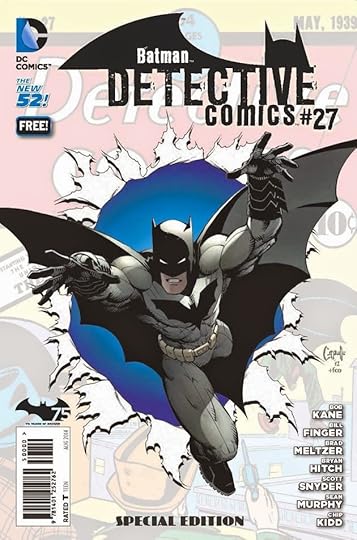
That is all.
Published on June 05, 2014 20:24
“Schoolhouse Rock” interview: songwriter/singer Bob Dorough
Introduction to the Schoolhouse Rock interview series (including the list of interviewees).
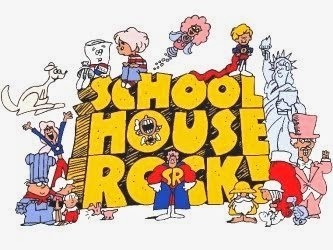
Among Bob’s greatest Schoolhouse Rock hits:
M = wrote music
L = wrote lyrics
S = sang song
“Three Is a Magic Number” – MLS“Ready or Not, Here I Come” (fives) – MLS“Figure Eight” – ML“Conjunction Junction” – M“Lolly, Lolly, Lolly, Get Your Adverbs Here” – MLS“Verb: That’s What’s Happenin’” – ML“Mother Necessity” – MLS (among other singers)“The Shot Heard ‘Round the World” – MLS“Sufferin’ til Suffrage” – M
How old were you when you began writing/singing for Schoolhouse Rock?
I would have been already 50 years old in December of 1973. By this time, Schoolhouse Rock had been on television since February. So as I began those songs, I was perhaps 47 or 48. I was never overly-conscious of age, per se, so it didn’t matter.
 1976 What else were you doing professionally at the time?
1976 What else were you doing professionally at the time?
I was engaged in creating some advertising music, having already produced and arranged for two or three LPs of the hot group Spanky and Our Gang. Plus, doing any jazz engagements I could scare up.
Where were you living at the time?
Where I live now, with one foot still in Long Island City, where I previously lived. One of my advertising pieces made me enough money for the down payment on my Pocono house. Legally I had changed my residence to Pennsylvania by 1966, i.e., before I’d met David B. McCall [the advertising executive who conceived of Schoolhouse Rock].
What did you think of the Schoolhouse Rock concept when it was pitched to you?
I was excited but cautious. I thought the idea was a bit puerile but then McCall added a line that shook my timbers. He said “But don’t write down to the children.” I was excited by the idea of being able to write for children (I was already a father myself) [but] cautious [in case] they wanted simplicity, like a jingle or something. (It seems he’d already sought the help of other NYC jingle composers.) His second line opened the floodgates of my life and experience in jazz, blues, and pop music.
How were you hired? Were you originally hired to write multiple songs, or just one?
There was no hiring. When they heard “Three Is a Magic Number” they (McCall and his executives) said “Oh, that’s what we’re looking for. Do some more.”
Did you have any say in which topics you got to write about?
It started as an idea to put the multiplication tables to “rock” music and call it “Multiplication Rock.” McCall wanted to finance an LP recording of the songs but, of necessity, we only went one song at a time. The recording process did begin rather early with the first session and I was being paid as an arranger and band leader in the union-approved sessions.
Did you propose any songs/topics that were rejected?
Actually, the first session tackled two songs I had written for them, “Three Is a Magic Number” and “Do Your Sevenses.” Later on, “Do Your Sevenses” was rejected. There were no “topics” at this point—just numbers.
How long would it take you, on average, to write a Schoolhouse Rock song? Did you do your own research or were you presented with which facts to include?
The first presentation consisted of me traveling to their NYC office with a cassette or tape of my song. After McCall’s challenge, I took two weeks before I brought in the “Three” song. During this two weeks, I did my own research. I had a collection of diverse math books, including one on “The New Math.” I was a sort of amateur mathematician. I imagine most musicians are into numbers quite naturally. After the animation phase began, there were hired researchers for subjects like grammar, history, and science. There was also more control in the song subjects and, of course, other songwriters at hand.
You are single-handedly responsible for many of Schoolhouse Rock’s greatest hits. Which song you wrote was your favorite and why?
I’d have to say, although it’s like asking a mother to name her favorite child, that “Three Is a Magic Number” would be my fave, since it literally got me the job. By default I was eventually hired as musical director of the projects.
Which Schoolhouse Rock song was your favorite to sing?
“Lucky Seven Sampson,” my second song about seven, was and is a favorite—a signature song of mine because, in a way, it is the story of my life.
What is your favorite Schoolhouse Rock song you did not write?
“The Tale of Mr. Morton” by Lynn Ahrens. She has the knack for telling a story that also gets the message through.
Of all songs you have written (not just Schoolhouse Rock), which is your favorite?
Again, do I have to finger one of my children? I love “Nothing Like You,” which I wrote to a Fran Landesman lyric and which was recorded by Miles Davis.
Any funny stories from the recordings?
Sessions are always funny because musicians are a funny lot. However, it (the session) is also serious business. I had an opportunity to hire some of my friends and to become friends with some musicians I hadn’t known before. There was the pleasure of providing them with work in the studio.
What did you think of the finished animated musical shorts?
Well, imagine me, a 50-year old veteran of World War II and a hodgepodge musical career, watching Saturday morning cartoons. I was thrilled to hear my voice on the mysterious telly.
How were you paid—salary, flat fee per song, royalty per song, other?
I was paid very well. There was a fee for each accepted song and this fee increased as the years went by. Plus I made union wages whenever I was in the studio as leader/pianist, arranger, and sometimes even as copyist. My pal and partner Ben Tucker often got extra pay as contractor, as well as for playing the bass.
What are your most cherished/funniest Schoolhouse Rock stories since (a reaction when someone you meet discovers you had a role in it, seeing its influence in an unexpected way, hearing a celeb you admire sing its praises, etc.)?
We all get a thrill when Rachel Maddow talks about “I’m Just a Bill” or “Conjunction Junction.” It’s amazing how the oeuvre has penetrated the national consciousness. Of course I meet countless people in my jazz work that turn out to hear “the Schoolhouse Rock guy.” It’s like food, all the tribute and love I get from schoolteachers who still use the DVD in their classrooms. I admire all those brave schoolteachers.
What are you working on these days?
Mostly, I work on my jazz singing career/songwriting successes and the like. Without the stimulus of Schoolhouse Rock, I don’t write as many songs but, now and then, I get an idea and am able to flush it out into a song.
 2011
2011
What do you consider your career highlight to date?
Singing with Miles Davis.
Where do you live?
In Northeastern Pennsylvania, just 70 miles west of the Apple.
If you have kids/grandkids, what did they think of your Schoolhouse Rock songs?
My only child is Aralee. She was just 8 and 9 when I started Multiplication Rock. She was the perfect sounding board and [took] part in several recordings (the children in “The Four Legged Zoo” and the voice in “My Hero Zero”). She is now the principal flutist of the Houston Symphony Orchestra and also plays jazz. I have one grandson and several step-grandchildren and they all think I am the cat’s pajamas.
What did you think when you first heard from me?
Oy vey, another one! I have written several times about my take on the subject and consider it my property—even what I’ve written for you.
Has anyone else ever interviewed about this? If so, when and for what publication?
It’s in all my PR—there was that magnificent Oxford Magazine article. So many—I’ve forgotten.
Do you still have any ongoing connection (professionally or personally) to Schoolhouse Rock?
I am the only one who speaks for and performs Schoolhouse Rock. I work in elementary schools in my area and wherever. Sometime I combine a jazz club gig with one of the schools in that (whatever) city. George Newall, Gill Dyrli, and I sometimes work in educational or technological conventions. Dr. Dyrli was hired as a consultant starting with the Grammar days, I think. I called him the “Grammar Guru.” And George Newall was a musician in Mad Men disguise. He majored in composition and played jazz piano in college, as I did; but he was one of McCall’s major advertising writers. Later on, he contributed several songs including the fabulous “Unpack Your Adjectives.”
Have you appeared at any fan conventions to sign autographs? If not, would you?
Yes, the aforementioned educational conventions gave me lots of talks with fans and I have signed many, many autographs for kids from 90 to 2.
What is your perspective on the longevity and legacy of Schoolhouse Rock?
I think it is here to stay, in whatever form the media take.
How do you look back on the experience?
It is probable that a lot of the kids watching cartoons in the ‘70s grew up and perhaps worked in jazz bars as waiters, working their way through college or something. It was [in such bars], in the ‘80s, that one of them might say “I like your voice. It sounds familiar. Did you ever do any of that stuff called—what was it? Schoolhouse Rock?” This soon led me to insert the songs from Schoolhouse Rock into my jazz sets.
One of my shows is called Schoolhouse Rock and All That Jazz. Another, which was never produced, is a personal memoir called How I Wrote Multiplication Rock and Still Swung.
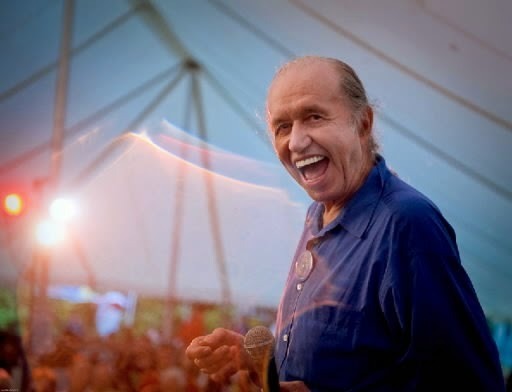 2011
2011
Anything you’d like to add?
I receive more than my due credit as “the creator of Schoolhouse Rock,” etc. As the most visible representative of Schoolhouse Rock, I am out there, on the line, as it were, where I sing the songs and keep them alive.
But I owe a lot to Ben Tucker. He introduced my music to George Newall, who, as a jazz fan, used to hear Ben playing bass with Billy Taylor and/or Marion McPartland. This led to my first meeting with McCall after Ben told George that I was a guy who could “put anything to music.”
I owe so much to Tom Yohe for his brilliant animation design and to George Newall for his musical support and the fact that he gave me the title for “Conjunction Junction.”
Lynn Ahrens, for her brilliant lyrics and contributions to the project that made it such a classy act. She of course has since distinguished herself as a Broadway lyricist and librettist.
We owe much to the singing of Jack Sheldon. George says he is “the cartoon voice of the century.”
Then there is the songwriter, Dave Frishberg. He got off to a slow start with “I’m Just a Bill” as his sole contribution until we launched a fifth series called “Money Rock” where he practically stole the show.
We have not mentioned the BAM Theater Group—a bunch of “kids” who remembered Schoolhouse Rock and said, “Hey, let’s do a show.” Schoolhouse Rock Live! is now available for renting and producing in your own school or hometown, just like My Fair Lady or Bye Bye Birdie.

Next: Lynn Ahrens.

Among Bob’s greatest Schoolhouse Rock hits:
M = wrote music
L = wrote lyrics
S = sang song
“Three Is a Magic Number” – MLS“Ready or Not, Here I Come” (fives) – MLS“Figure Eight” – ML“Conjunction Junction” – M“Lolly, Lolly, Lolly, Get Your Adverbs Here” – MLS“Verb: That’s What’s Happenin’” – ML“Mother Necessity” – MLS (among other singers)“The Shot Heard ‘Round the World” – MLS“Sufferin’ til Suffrage” – M
How old were you when you began writing/singing for Schoolhouse Rock?
I would have been already 50 years old in December of 1973. By this time, Schoolhouse Rock had been on television since February. So as I began those songs, I was perhaps 47 or 48. I was never overly-conscious of age, per se, so it didn’t matter.
 1976 What else were you doing professionally at the time?
1976 What else were you doing professionally at the time?I was engaged in creating some advertising music, having already produced and arranged for two or three LPs of the hot group Spanky and Our Gang. Plus, doing any jazz engagements I could scare up.
Where were you living at the time?
Where I live now, with one foot still in Long Island City, where I previously lived. One of my advertising pieces made me enough money for the down payment on my Pocono house. Legally I had changed my residence to Pennsylvania by 1966, i.e., before I’d met David B. McCall [the advertising executive who conceived of Schoolhouse Rock].
What did you think of the Schoolhouse Rock concept when it was pitched to you?
I was excited but cautious. I thought the idea was a bit puerile but then McCall added a line that shook my timbers. He said “But don’t write down to the children.” I was excited by the idea of being able to write for children (I was already a father myself) [but] cautious [in case] they wanted simplicity, like a jingle or something. (It seems he’d already sought the help of other NYC jingle composers.) His second line opened the floodgates of my life and experience in jazz, blues, and pop music.
How were you hired? Were you originally hired to write multiple songs, or just one?
There was no hiring. When they heard “Three Is a Magic Number” they (McCall and his executives) said “Oh, that’s what we’re looking for. Do some more.”
Did you have any say in which topics you got to write about?
It started as an idea to put the multiplication tables to “rock” music and call it “Multiplication Rock.” McCall wanted to finance an LP recording of the songs but, of necessity, we only went one song at a time. The recording process did begin rather early with the first session and I was being paid as an arranger and band leader in the union-approved sessions.
Did you propose any songs/topics that were rejected?
Actually, the first session tackled two songs I had written for them, “Three Is a Magic Number” and “Do Your Sevenses.” Later on, “Do Your Sevenses” was rejected. There were no “topics” at this point—just numbers.
How long would it take you, on average, to write a Schoolhouse Rock song? Did you do your own research or were you presented with which facts to include?
The first presentation consisted of me traveling to their NYC office with a cassette or tape of my song. After McCall’s challenge, I took two weeks before I brought in the “Three” song. During this two weeks, I did my own research. I had a collection of diverse math books, including one on “The New Math.” I was a sort of amateur mathematician. I imagine most musicians are into numbers quite naturally. After the animation phase began, there were hired researchers for subjects like grammar, history, and science. There was also more control in the song subjects and, of course, other songwriters at hand.
You are single-handedly responsible for many of Schoolhouse Rock’s greatest hits. Which song you wrote was your favorite and why?
I’d have to say, although it’s like asking a mother to name her favorite child, that “Three Is a Magic Number” would be my fave, since it literally got me the job. By default I was eventually hired as musical director of the projects.
Which Schoolhouse Rock song was your favorite to sing?
“Lucky Seven Sampson,” my second song about seven, was and is a favorite—a signature song of mine because, in a way, it is the story of my life.
What is your favorite Schoolhouse Rock song you did not write?
“The Tale of Mr. Morton” by Lynn Ahrens. She has the knack for telling a story that also gets the message through.
Of all songs you have written (not just Schoolhouse Rock), which is your favorite?
Again, do I have to finger one of my children? I love “Nothing Like You,” which I wrote to a Fran Landesman lyric and which was recorded by Miles Davis.
Any funny stories from the recordings?
Sessions are always funny because musicians are a funny lot. However, it (the session) is also serious business. I had an opportunity to hire some of my friends and to become friends with some musicians I hadn’t known before. There was the pleasure of providing them with work in the studio.
What did you think of the finished animated musical shorts?
Well, imagine me, a 50-year old veteran of World War II and a hodgepodge musical career, watching Saturday morning cartoons. I was thrilled to hear my voice on the mysterious telly.
How were you paid—salary, flat fee per song, royalty per song, other?
I was paid very well. There was a fee for each accepted song and this fee increased as the years went by. Plus I made union wages whenever I was in the studio as leader/pianist, arranger, and sometimes even as copyist. My pal and partner Ben Tucker often got extra pay as contractor, as well as for playing the bass.
What are your most cherished/funniest Schoolhouse Rock stories since (a reaction when someone you meet discovers you had a role in it, seeing its influence in an unexpected way, hearing a celeb you admire sing its praises, etc.)?
We all get a thrill when Rachel Maddow talks about “I’m Just a Bill” or “Conjunction Junction.” It’s amazing how the oeuvre has penetrated the national consciousness. Of course I meet countless people in my jazz work that turn out to hear “the Schoolhouse Rock guy.” It’s like food, all the tribute and love I get from schoolteachers who still use the DVD in their classrooms. I admire all those brave schoolteachers.
What are you working on these days?
Mostly, I work on my jazz singing career/songwriting successes and the like. Without the stimulus of Schoolhouse Rock, I don’t write as many songs but, now and then, I get an idea and am able to flush it out into a song.
 2011
2011What do you consider your career highlight to date?
Singing with Miles Davis.
Where do you live?
In Northeastern Pennsylvania, just 70 miles west of the Apple.
If you have kids/grandkids, what did they think of your Schoolhouse Rock songs?
My only child is Aralee. She was just 8 and 9 when I started Multiplication Rock. She was the perfect sounding board and [took] part in several recordings (the children in “The Four Legged Zoo” and the voice in “My Hero Zero”). She is now the principal flutist of the Houston Symphony Orchestra and also plays jazz. I have one grandson and several step-grandchildren and they all think I am the cat’s pajamas.
What did you think when you first heard from me?
Oy vey, another one! I have written several times about my take on the subject and consider it my property—even what I’ve written for you.
Has anyone else ever interviewed about this? If so, when and for what publication?
It’s in all my PR—there was that magnificent Oxford Magazine article. So many—I’ve forgotten.
Do you still have any ongoing connection (professionally or personally) to Schoolhouse Rock?
I am the only one who speaks for and performs Schoolhouse Rock. I work in elementary schools in my area and wherever. Sometime I combine a jazz club gig with one of the schools in that (whatever) city. George Newall, Gill Dyrli, and I sometimes work in educational or technological conventions. Dr. Dyrli was hired as a consultant starting with the Grammar days, I think. I called him the “Grammar Guru.” And George Newall was a musician in Mad Men disguise. He majored in composition and played jazz piano in college, as I did; but he was one of McCall’s major advertising writers. Later on, he contributed several songs including the fabulous “Unpack Your Adjectives.”
Have you appeared at any fan conventions to sign autographs? If not, would you?
Yes, the aforementioned educational conventions gave me lots of talks with fans and I have signed many, many autographs for kids from 90 to 2.
What is your perspective on the longevity and legacy of Schoolhouse Rock?
I think it is here to stay, in whatever form the media take.
How do you look back on the experience?
It is probable that a lot of the kids watching cartoons in the ‘70s grew up and perhaps worked in jazz bars as waiters, working their way through college or something. It was [in such bars], in the ‘80s, that one of them might say “I like your voice. It sounds familiar. Did you ever do any of that stuff called—what was it? Schoolhouse Rock?” This soon led me to insert the songs from Schoolhouse Rock into my jazz sets.
One of my shows is called Schoolhouse Rock and All That Jazz. Another, which was never produced, is a personal memoir called How I Wrote Multiplication Rock and Still Swung.
 2011
2011Anything you’d like to add?
I receive more than my due credit as “the creator of Schoolhouse Rock,” etc. As the most visible representative of Schoolhouse Rock, I am out there, on the line, as it were, where I sing the songs and keep them alive.
But I owe a lot to Ben Tucker. He introduced my music to George Newall, who, as a jazz fan, used to hear Ben playing bass with Billy Taylor and/or Marion McPartland. This led to my first meeting with McCall after Ben told George that I was a guy who could “put anything to music.”
I owe so much to Tom Yohe for his brilliant animation design and to George Newall for his musical support and the fact that he gave me the title for “Conjunction Junction.”
Lynn Ahrens, for her brilliant lyrics and contributions to the project that made it such a classy act. She of course has since distinguished herself as a Broadway lyricist and librettist.
We owe much to the singing of Jack Sheldon. George says he is “the cartoon voice of the century.”
Then there is the songwriter, Dave Frishberg. He got off to a slow start with “I’m Just a Bill” as his sole contribution until we launched a fifth series called “Money Rock” where he practically stole the show.
We have not mentioned the BAM Theater Group—a bunch of “kids” who remembered Schoolhouse Rock and said, “Hey, let’s do a show.” Schoolhouse Rock Live! is now available for renting and producing in your own school or hometown, just like My Fair Lady or Bye Bye Birdie.

Next: Lynn Ahrens.
Published on June 05, 2014 04:00
June 4, 2014
“Schoolhouse Rock” interview: co-creator/producer Rad Stone
Introduction to the Schoolhouse Rock interview series (including the list of interviewees).

What was your role on Schoolhouse Rock?
At McCaffrey & McCall, I was the “suit.” Everyone else was a “creative.” The original idea was to make a Multiplication Rock remedial education LP. When Tom Yohe, my hero, heard the “Three Is a Magic Number” song, he drew a storyboard on it. When I saw that I felt it might be a possibility for my client the ABC Television Network. Saturday a.m. was a goldmine then.
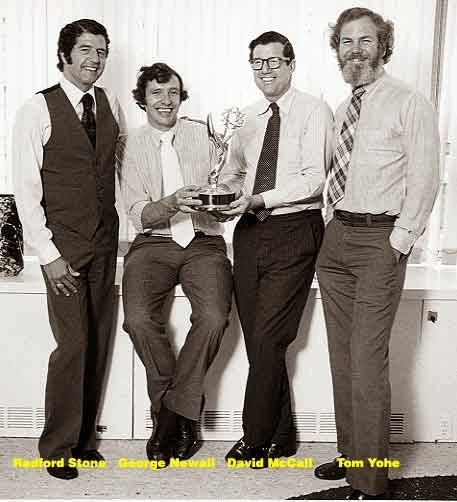 1977, after winning second Emmy
1977, after winning second Emmy
How old were you when you began working on Schoolhouse Rock?
40.
What else were you doing professionally at the time?
Senior VP Account Supervisor on ABC.
Where were you living at the time?
New Canaan, CT.
What did you think of the Schoolhouse Rock concept when it was pitched to you?
Nice…for an LP.
How were you hired?
McCaffrey hired me away from Ogilvy to run ABC.
Did you have any say in which topics the series covered?
No.
Did you propose any songs/topics that were rejected?
No.
How long would it take you, on average, to produce a Schoolhouse Rock song?
Two weeks for a song and track. Two months for the video.
Which Schoolhouse Rock song/video was your favorite and why?
“Figure Eight” [sung by] Blossom Dearie; “Fireworks” with parts for Radford, Ian, and Charlotte Stone [his children].
Any funny stories from the recordings?
Not repeatable.
What did you think of the finished animated musical shorts?
A+.
Any controversy over Schoolhouse Rock?
Only on the business/ownership side.
What are your most cherished/funniest Schoolhouse Rock stories since (a reaction when someone you meet discovers you had a role in it, seeing its influence in an unexpected way, hearing a celeb you admire sing its praises, etc.)?
Celebs talk about “I’m Just a Bill,” “The Preamble,” “Conjunction Junction,” etc. all the time.
What do you consider your career highlight to date?
Four Emmys wasn’t too shabby (Yohe made me a producer).
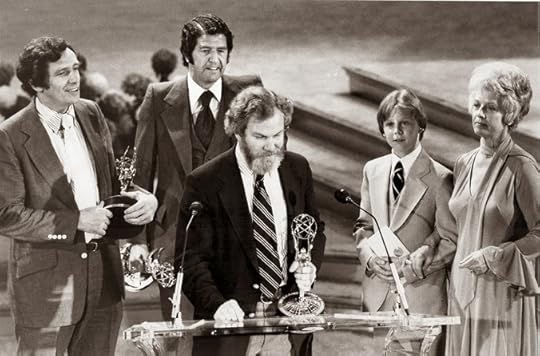 Newall, Stone, Yohe, 1978
Newall, Stone, Yohe, 1978
Where do you live?
North Carolina.
If you have kids/grandkids, what did they think of your Schoolhouse Rock role?
Lotsa T-shirts!
What did you think when you first heard from me?
What’s Charlotte up to? [Charlotte is Rad’s daughter, who connected me to him.]
Has anyone else ever interviewed about this? If so, when and for what publication?
Tom and George [Newall] had several.
Do you still have any ongoing connection (professionally or personally) to Schoolhouse Rock?
Digital distribution of Schoolhouse Rock. George and I run it. Couple of octogenarians. Bobby [Dorough]’s 90! ABC/Disney own it.
Have you appeared at any fan conventions to sign autographs? If not, would you?
We have and would.
What is your perspective on the longevity and legacy of Schoolhouse Rock?
It’s pretty secure with the two musicals with 300 performance dates a year.
How do you look back on the experience?
Pretty favorably, since I retired in 1991!
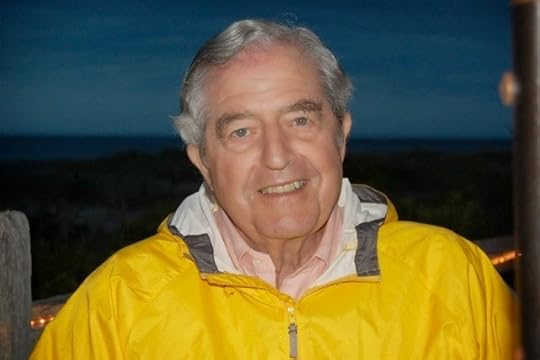
Next: Bob Dorough.

What was your role on Schoolhouse Rock?
At McCaffrey & McCall, I was the “suit.” Everyone else was a “creative.” The original idea was to make a Multiplication Rock remedial education LP. When Tom Yohe, my hero, heard the “Three Is a Magic Number” song, he drew a storyboard on it. When I saw that I felt it might be a possibility for my client the ABC Television Network. Saturday a.m. was a goldmine then.
 1977, after winning second Emmy
1977, after winning second Emmy
How old were you when you began working on Schoolhouse Rock?
40.
What else were you doing professionally at the time?
Senior VP Account Supervisor on ABC.
Where were you living at the time?
New Canaan, CT.
What did you think of the Schoolhouse Rock concept when it was pitched to you?
Nice…for an LP.
How were you hired?
McCaffrey hired me away from Ogilvy to run ABC.
Did you have any say in which topics the series covered?
No.
Did you propose any songs/topics that were rejected?
No.
How long would it take you, on average, to produce a Schoolhouse Rock song?
Two weeks for a song and track. Two months for the video.
Which Schoolhouse Rock song/video was your favorite and why?
“Figure Eight” [sung by] Blossom Dearie; “Fireworks” with parts for Radford, Ian, and Charlotte Stone [his children].
Any funny stories from the recordings?
Not repeatable.
What did you think of the finished animated musical shorts?
A+.
Any controversy over Schoolhouse Rock?
Only on the business/ownership side.
What are your most cherished/funniest Schoolhouse Rock stories since (a reaction when someone you meet discovers you had a role in it, seeing its influence in an unexpected way, hearing a celeb you admire sing its praises, etc.)?
Celebs talk about “I’m Just a Bill,” “The Preamble,” “Conjunction Junction,” etc. all the time.
What do you consider your career highlight to date?
Four Emmys wasn’t too shabby (Yohe made me a producer).
 Newall, Stone, Yohe, 1978
Newall, Stone, Yohe, 1978
Where do you live?
North Carolina.
If you have kids/grandkids, what did they think of your Schoolhouse Rock role?
Lotsa T-shirts!
What did you think when you first heard from me?
What’s Charlotte up to? [Charlotte is Rad’s daughter, who connected me to him.]
Has anyone else ever interviewed about this? If so, when and for what publication?
Tom and George [Newall] had several.
Do you still have any ongoing connection (professionally or personally) to Schoolhouse Rock?
Digital distribution of Schoolhouse Rock. George and I run it. Couple of octogenarians. Bobby [Dorough]’s 90! ABC/Disney own it.
Have you appeared at any fan conventions to sign autographs? If not, would you?
We have and would.
What is your perspective on the longevity and legacy of Schoolhouse Rock?
It’s pretty secure with the two musicals with 300 performance dates a year.
How do you look back on the experience?
Pretty favorably, since I retired in 1991!

Next: Bob Dorough.
Published on June 04, 2014 04:00
June 3, 2014
“Schoolhouse Rock” interview: co-creator/ producer/songwriter George Newall
Introduction to the Schoolhouse Rock interview series (including the list of interviewees).

What was your role on Schoolhouse Rock?
In the early ‘70s, I was co-creative director of McCaffrey & McCall, a mid-sized New York advertising agency. It was my habit to get to the office around 7 a.m. Often, that would lead to my having coffee with another “early bird,” my boss, David McCall. (Dave had previously hired me as a copywriter at Ogilvy, Benson & Mather when he was copy chief there in 1963.)
One morning as we chatted, Dave told me about taking his kids on a dude ranch vacation. His son, Davey Jr., had been having a lot of trouble with multiplication tables in school, but Dave noticed that as they were riding along the kid was singing the lyrics to every rock & roll hit of the day. What if we produced an educational phonograph record of the multiplication tables set to rock music? Great idea. But Dave said he had no idea who could write that kind of music.
Actually, I didn’t either, but at the time I did a lot of hanging out at a club called the Hickory House on 52nd Street listening to Billy Taylor and his trio. One night I asked Billy’s bass player, Ben Tucker, if he knew anyone who could fill the bill. “Of course, “Ben said, “My partner, Bob Dorough.” Ben had started a jingle company with the longtime bop pianist. He told me of Bob’s recent record release This Is a Recording, in which Bob created songs from the words of mundane everyday objects like mattress tags, phone answering messages, and dictionary definitions of words like “love.”
We set up a meeting for Ben to bring Bob to meet Dave McCall. Dave told Bob his idea. Also in attendance was Tom Yohe, my co-creative director and head of the agency’s art department. Dave was very pointed in telling Bob not to talk down to kids as had been the case in most attempts to educate children through music (i.e. “The Singing Lady”). Bob then promised to return in a couple of weeks with a demo.
When Bob came back with “Three Is a Magic Number,” we were astonished. He had put the three times table into a context, based on the role of three in mathematics, religion, and even furniture-making.
So my role started as the catalyst in bringing Bob Dorough to Dave’s project. Subsequently, I continued as one of the producers, one of the composers, then co-executive producer, and after Tom Yohe’s untimely death in 2000, executive producer and president of our little subsidiary company, Scholastic Rock, Inc.
What else were you doing professionally at the time?
I ran the copy department of McCaffrey & McCall and supervised the creative work for half the agency’s clients. I had established a close working relationship with Tom Yohe when he began working with me on Hai Karate Aftershave (a product that I had “invented,” positioning it as a spoof of the Aqua Velva advertising campaign, “There’s Something About an Aqua Velva Man”).
Where were you living?
119 East 84th Street in Manhattan.
What did you think of the Schoolhouse Rock concept when it was pitched to you?
As a former musician, I was intrigued when Dave McCall first told me about it. But after hearing Bob Dorough’s first song, I was very excited.
Did you have any say in which topics the series covered?
Of course. I was one of the originators. And everything we did was collaborative. The atmosphere was always congenial, a reflection of the general atmosphere that made McCaffrey & McCall such a pleasure to work at. (I don’t recall any resemblance to what’s depicted on Mad Men even though I worked in the thick of that era!)
Did you propose any songs/topics that were rejected?
I don’t remember any specific incidents. The first song I wrote was “Unpack Your Adjectives,” then “Them Not So Dry Bones” and “Energy Blues.” In the early ‘90s, we produced an on-air series called Money Rock. I wrote “This for That,” a description of barter as an early form of currency.

When we produced the 30th Anniversary Edition DVD with Disney, I wrote the lead song, “I’m Gonna Send Your Vote to College.” It attempted to unravel the Electoral College. Tom Yohe, Jr. designed the animation. Jack Sheldon sang it on the soundtrack. (He also sang my song “Energy Blues” for the original Science Rock series.)
In 2007, I produced Schoolhouse Rock Earth for Disney Educational Productions. I originally meant it to be a series on geography, but the idea morphed into a DVD that dealt with today’s environmental issues. I’ll discuss that further in answering one of your other questions
However, I think the song that I’m most proud of is one that I didn’t write. In one of our brainstorming sessions, I came up with the concept and title for “Conjunction Junction.” It took Bob’s genius to make it work. And Tom’s design to make it stand out as the all-time favorite among those who grew up with Schoolhouse Rock.
How long would it take you, on average, to produce a Schoolhouse Rock song?
I’d say getting a song written would take anywhere between three weeks and a month. Getting the lyrics vetted by an educational consultant, another week, and then getting ABC on board, another two. The actual production of the animation was initially quite lengthy. Back in the day, animation cels were hand painted. There were no computers to help.
Of course, during the production of Schoolhouse Rock Earth, approvals from ABC/Disney became much harder to get. It seems that the new executives who had grown up watching the series became more expert at evaluating potential songs than we were. And I found that songs were being judged by the standards that had taken hold in using exhaustive research to produce “effective” advertising. Too many MBAs in the process.
Examples: We could not get even one of the songs Dave Frishberg wrote approved. And not even one of Bob Dorough’s original song proposals. He and I had to collaborate on “Report from the North Pole.” His eccentric style didn’t fit into any of the cookie-cutter molds the MBAs had created. I did get a couple of songs that I wrote included: “You Oughta Be Savin’ Water,” “Windy and the Windmills,” and “Don’t Be a Carbon Sasquatch.”
In the beginning, when we were producing Multiplication Rock, Mike Eisner was baffled by the premise of “Little Twelvetoes” and didn’t think kids would understand the concept. But our educational consultant from the Bank Street School of Education called Eisner and told him not to underestimate the kids. He said “Okay, you’re the expert,” and we produced the film. Clearly, those days are over!
Which Schoolhouse Rock song/video was your favorite and why?
“Three Is a Magic Number.” That was the song in which Bob Dorough created the conceptual approach that took steered us away from the mere repetition of numbers and facts.
Any funny stories from the recordings?
I can’t remember any single moments of hilarity. But, by the grace of Bob, every recording session was fun to be a part of. Just getting to work with the likes of Dave Frishberg, Jack Sheldon, and Blossom Dearie in the relaxed atmosphere that Bob created when he ran the sessions was great fun.
What did you think of the finished animated musical shorts?
I thought most of them were wonderful. One visual standout was Roland Wilson’s design of “Little Twelvetoes,” one of Bob’s most unique concepts. And, of course, anything that Tom Yohe designed worked. He set what became the familiar “look” of Schoolhouse Rock. And after Tom’s death, the same can be said for his son Tom. (Tom Jr. is an artistic clone of his dad!) Tom Jr. designed “Mr. Morton” and “I’m Gonna Send Your Vote to College.”
Funny, to me there were songs that were successful because of the music, like the alliterative “Conjunction Junction.” Then there were songs in which the animated character was most memorable, like “I’m Just a Bill.” In it, Dave Frishberg’s lyric lays out the information in a relatively straightforward way. But Tom’s “funny little scrap of paper” is what keeps the songs popping up on MSNBC, late night, and even in Congress itself! Here, a southern senator uses Bill’s image to make a point I didn’t agree with:

Any controversy over Schoolhouse Rock?
Probably the most egregious case was ABC not putting Lynn Ahrens’s “Three Ring Government” on the air because of their fear that the FCC and Congress would resent being compared to a circus and threaten their broadcast license renewal.
Then there was the politically incorrect use of manifest destiny in “Elbow Room.” (It was a justification for expanding to the West at that time in our history!)
One galling moment for Tom and me was during the ‘90s when one of the former ABC Children’s’ Programming executives started marketing himself as the “Father of Schoolhouse Rock” when, in fact, it was he who had taken us off the air and replaced Schoolhouse Rock with a fitness series starring Mary Lou Retton.
Then, most recently, there were the reviews on iTunes of Schoolhouse Rock Earth that accused Disney of producing nothing but “climate change propaganda.”
What are your most cherished/funniest Schoolhouse Rock stories since (a reaction when someone you meet discovers you had a role in it, seeing its influence in an unexpected way, hearing a celeb you admire sing its praises, etc.)?
There are literally hundreds of these gratifying moments; from people I play golf with to Rachel Maddow and Wolf Blitzer and even President Obama himself!
I was invited to production of Schoolhouse Rock! Live, Jr. put on by the third grade of local school. (Schoolhouse Rock! Live was initially produced by Theatre Bam in Chicago. It ran briefly in NYC, off Broadway. And it is now licensed though Music Theater International. For almost ten years now, there have been a total of more than 500 individual productions a year—around the world! (Army bases, I suspect.)
But perhaps the most gratifying for me was this year at the Kennedy Center in Washington, DC. The center sponsored a “Schoolhouse Rock 40th Anniversary Singalong” featuring Bob Dorough. The event drew the biggest audience in the history of the center’s Millennium Stage (over 2,000 people!). And in the post-concert autograph session, I had the incredible experience of being told by three different Asian couples that their kids could never have learned English without Grammar Rock!
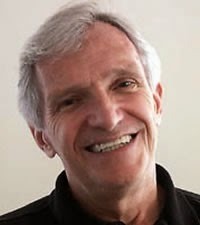
What are you working on these days?
Mostly my golf swing (a curse!). Also keeping track of merchandising deals made by ABC and helping my wife with her singing. I did have the fun of producing a CD with her right here in my basement. I did all the arranging and played all the parts in on my Mac. There was only one live “recorded in a studio” musician on the album, John Allred, a terrific trombonist.
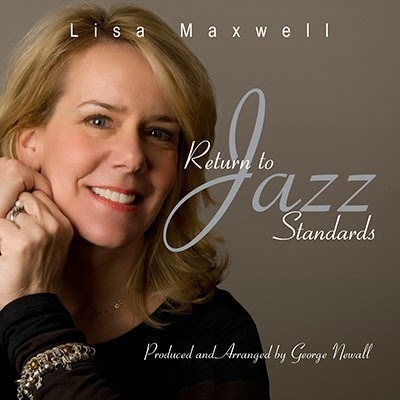
Where do you live?
Hastings-on-Hudson, NY.
If you have kids/grandkids, what did they think of your Schoolhouse Rock songs?
I have one stepson. It’s hard to tell what he’s ever thinking!
Has anyone else ever interviewed about this? If so, when and for what publication?
Yes, many times. Several times with Bob on NPR. By our local newspaper, The Rivertowns Enterprise, which headlined it as an interview with “a rock star.” Florida State University’s FM station. Charlie Gibson on ABC in the ‘90s (with Tom) and Jane Clayson on the CBS Morning Show (with Bob and Jack Sheldon).
Do you still have any ongoing connection (professionally or personally) to Schoolhouse Rock?
I’m Executive Producer, President and Chairman of the Board of Scholastic Rock, Inc.
Have you appeared at any fan conventions to sign autographs? If not, would you?
Bob Dorough, our education consultant, Gil Dyrli, and I do seminars for educational groups, etc.

What is your perspective on the longevity and legacy of Schoolhouse Rock?
I’m pretty sure Schoolhouse Rock will be around after I’m gone. The films are evergreens and every year a brand new audience arrives in grade school.
Next: Rad Stone.

What was your role on Schoolhouse Rock?
In the early ‘70s, I was co-creative director of McCaffrey & McCall, a mid-sized New York advertising agency. It was my habit to get to the office around 7 a.m. Often, that would lead to my having coffee with another “early bird,” my boss, David McCall. (Dave had previously hired me as a copywriter at Ogilvy, Benson & Mather when he was copy chief there in 1963.)
One morning as we chatted, Dave told me about taking his kids on a dude ranch vacation. His son, Davey Jr., had been having a lot of trouble with multiplication tables in school, but Dave noticed that as they were riding along the kid was singing the lyrics to every rock & roll hit of the day. What if we produced an educational phonograph record of the multiplication tables set to rock music? Great idea. But Dave said he had no idea who could write that kind of music.
Actually, I didn’t either, but at the time I did a lot of hanging out at a club called the Hickory House on 52nd Street listening to Billy Taylor and his trio. One night I asked Billy’s bass player, Ben Tucker, if he knew anyone who could fill the bill. “Of course, “Ben said, “My partner, Bob Dorough.” Ben had started a jingle company with the longtime bop pianist. He told me of Bob’s recent record release This Is a Recording, in which Bob created songs from the words of mundane everyday objects like mattress tags, phone answering messages, and dictionary definitions of words like “love.”
We set up a meeting for Ben to bring Bob to meet Dave McCall. Dave told Bob his idea. Also in attendance was Tom Yohe, my co-creative director and head of the agency’s art department. Dave was very pointed in telling Bob not to talk down to kids as had been the case in most attempts to educate children through music (i.e. “The Singing Lady”). Bob then promised to return in a couple of weeks with a demo.
When Bob came back with “Three Is a Magic Number,” we were astonished. He had put the three times table into a context, based on the role of three in mathematics, religion, and even furniture-making.
So my role started as the catalyst in bringing Bob Dorough to Dave’s project. Subsequently, I continued as one of the producers, one of the composers, then co-executive producer, and after Tom Yohe’s untimely death in 2000, executive producer and president of our little subsidiary company, Scholastic Rock, Inc.
What else were you doing professionally at the time?
I ran the copy department of McCaffrey & McCall and supervised the creative work for half the agency’s clients. I had established a close working relationship with Tom Yohe when he began working with me on Hai Karate Aftershave (a product that I had “invented,” positioning it as a spoof of the Aqua Velva advertising campaign, “There’s Something About an Aqua Velva Man”).
Where were you living?
119 East 84th Street in Manhattan.
What did you think of the Schoolhouse Rock concept when it was pitched to you?
As a former musician, I was intrigued when Dave McCall first told me about it. But after hearing Bob Dorough’s first song, I was very excited.
Did you have any say in which topics the series covered?
Of course. I was one of the originators. And everything we did was collaborative. The atmosphere was always congenial, a reflection of the general atmosphere that made McCaffrey & McCall such a pleasure to work at. (I don’t recall any resemblance to what’s depicted on Mad Men even though I worked in the thick of that era!)
Did you propose any songs/topics that were rejected?
I don’t remember any specific incidents. The first song I wrote was “Unpack Your Adjectives,” then “Them Not So Dry Bones” and “Energy Blues.” In the early ‘90s, we produced an on-air series called Money Rock. I wrote “This for That,” a description of barter as an early form of currency.

When we produced the 30th Anniversary Edition DVD with Disney, I wrote the lead song, “I’m Gonna Send Your Vote to College.” It attempted to unravel the Electoral College. Tom Yohe, Jr. designed the animation. Jack Sheldon sang it on the soundtrack. (He also sang my song “Energy Blues” for the original Science Rock series.)
In 2007, I produced Schoolhouse Rock Earth for Disney Educational Productions. I originally meant it to be a series on geography, but the idea morphed into a DVD that dealt with today’s environmental issues. I’ll discuss that further in answering one of your other questions
However, I think the song that I’m most proud of is one that I didn’t write. In one of our brainstorming sessions, I came up with the concept and title for “Conjunction Junction.” It took Bob’s genius to make it work. And Tom’s design to make it stand out as the all-time favorite among those who grew up with Schoolhouse Rock.
How long would it take you, on average, to produce a Schoolhouse Rock song?
I’d say getting a song written would take anywhere between three weeks and a month. Getting the lyrics vetted by an educational consultant, another week, and then getting ABC on board, another two. The actual production of the animation was initially quite lengthy. Back in the day, animation cels were hand painted. There were no computers to help.
Of course, during the production of Schoolhouse Rock Earth, approvals from ABC/Disney became much harder to get. It seems that the new executives who had grown up watching the series became more expert at evaluating potential songs than we were. And I found that songs were being judged by the standards that had taken hold in using exhaustive research to produce “effective” advertising. Too many MBAs in the process.
Examples: We could not get even one of the songs Dave Frishberg wrote approved. And not even one of Bob Dorough’s original song proposals. He and I had to collaborate on “Report from the North Pole.” His eccentric style didn’t fit into any of the cookie-cutter molds the MBAs had created. I did get a couple of songs that I wrote included: “You Oughta Be Savin’ Water,” “Windy and the Windmills,” and “Don’t Be a Carbon Sasquatch.”
In the beginning, when we were producing Multiplication Rock, Mike Eisner was baffled by the premise of “Little Twelvetoes” and didn’t think kids would understand the concept. But our educational consultant from the Bank Street School of Education called Eisner and told him not to underestimate the kids. He said “Okay, you’re the expert,” and we produced the film. Clearly, those days are over!
Which Schoolhouse Rock song/video was your favorite and why?
“Three Is a Magic Number.” That was the song in which Bob Dorough created the conceptual approach that took steered us away from the mere repetition of numbers and facts.
Any funny stories from the recordings?
I can’t remember any single moments of hilarity. But, by the grace of Bob, every recording session was fun to be a part of. Just getting to work with the likes of Dave Frishberg, Jack Sheldon, and Blossom Dearie in the relaxed atmosphere that Bob created when he ran the sessions was great fun.
What did you think of the finished animated musical shorts?
I thought most of them were wonderful. One visual standout was Roland Wilson’s design of “Little Twelvetoes,” one of Bob’s most unique concepts. And, of course, anything that Tom Yohe designed worked. He set what became the familiar “look” of Schoolhouse Rock. And after Tom’s death, the same can be said for his son Tom. (Tom Jr. is an artistic clone of his dad!) Tom Jr. designed “Mr. Morton” and “I’m Gonna Send Your Vote to College.”
Funny, to me there were songs that were successful because of the music, like the alliterative “Conjunction Junction.” Then there were songs in which the animated character was most memorable, like “I’m Just a Bill.” In it, Dave Frishberg’s lyric lays out the information in a relatively straightforward way. But Tom’s “funny little scrap of paper” is what keeps the songs popping up on MSNBC, late night, and even in Congress itself! Here, a southern senator uses Bill’s image to make a point I didn’t agree with:

Any controversy over Schoolhouse Rock?
Probably the most egregious case was ABC not putting Lynn Ahrens’s “Three Ring Government” on the air because of their fear that the FCC and Congress would resent being compared to a circus and threaten their broadcast license renewal.
Then there was the politically incorrect use of manifest destiny in “Elbow Room.” (It was a justification for expanding to the West at that time in our history!)
One galling moment for Tom and me was during the ‘90s when one of the former ABC Children’s’ Programming executives started marketing himself as the “Father of Schoolhouse Rock” when, in fact, it was he who had taken us off the air and replaced Schoolhouse Rock with a fitness series starring Mary Lou Retton.
Then, most recently, there were the reviews on iTunes of Schoolhouse Rock Earth that accused Disney of producing nothing but “climate change propaganda.”
What are your most cherished/funniest Schoolhouse Rock stories since (a reaction when someone you meet discovers you had a role in it, seeing its influence in an unexpected way, hearing a celeb you admire sing its praises, etc.)?
There are literally hundreds of these gratifying moments; from people I play golf with to Rachel Maddow and Wolf Blitzer and even President Obama himself!
I was invited to production of Schoolhouse Rock! Live, Jr. put on by the third grade of local school. (Schoolhouse Rock! Live was initially produced by Theatre Bam in Chicago. It ran briefly in NYC, off Broadway. And it is now licensed though Music Theater International. For almost ten years now, there have been a total of more than 500 individual productions a year—around the world! (Army bases, I suspect.)
But perhaps the most gratifying for me was this year at the Kennedy Center in Washington, DC. The center sponsored a “Schoolhouse Rock 40th Anniversary Singalong” featuring Bob Dorough. The event drew the biggest audience in the history of the center’s Millennium Stage (over 2,000 people!). And in the post-concert autograph session, I had the incredible experience of being told by three different Asian couples that their kids could never have learned English without Grammar Rock!

What are you working on these days?
Mostly my golf swing (a curse!). Also keeping track of merchandising deals made by ABC and helping my wife with her singing. I did have the fun of producing a CD with her right here in my basement. I did all the arranging and played all the parts in on my Mac. There was only one live “recorded in a studio” musician on the album, John Allred, a terrific trombonist.

Where do you live?
Hastings-on-Hudson, NY.
If you have kids/grandkids, what did they think of your Schoolhouse Rock songs?
I have one stepson. It’s hard to tell what he’s ever thinking!
Has anyone else ever interviewed about this? If so, when and for what publication?
Yes, many times. Several times with Bob on NPR. By our local newspaper, The Rivertowns Enterprise, which headlined it as an interview with “a rock star.” Florida State University’s FM station. Charlie Gibson on ABC in the ‘90s (with Tom) and Jane Clayson on the CBS Morning Show (with Bob and Jack Sheldon).
Do you still have any ongoing connection (professionally or personally) to Schoolhouse Rock?
I’m Executive Producer, President and Chairman of the Board of Scholastic Rock, Inc.
Have you appeared at any fan conventions to sign autographs? If not, would you?
Bob Dorough, our education consultant, Gil Dyrli, and I do seminars for educational groups, etc.

What is your perspective on the longevity and legacy of Schoolhouse Rock?
I’m pretty sure Schoolhouse Rock will be around after I’m gone. The films are evergreens and every year a brand new audience arrives in grade school.
Next: Rad Stone.
Published on June 03, 2014 04:00
June 2, 2014
“Schoolhouse Rock” interviews: introduction
In 1973, in one way, Saturday morning started to look like Monday to Friday morning: it got educational...but not via school. Via TV.
That was the year that Schoolhouse Rock! (animated musical shorts teaching multiplication, grammar, science, American history, and more) debuted during commercial breaks on ABC.
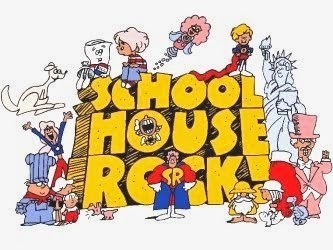
Like many people my age, I consumed them as readily as the Frosted Flakes I enjoyed while doing so. And so like I have done before, I tracked down the talent who brought us these landmark, Emmy-winning cartoons.
This series features original interviews with most of the key surviving creators:
George Newall , co-creator/producer/songwriter Rad Stone , co-creator/producer Bob Dorough , songwriter/singer Lynn Ahrens , songwriter/singer Dave Frishberg , songwriter Essra Mohawk , singer Lori Lieberman , singer
Among the talent involved with the series whom I am regrettably too late to reach:
David McCall, co-creator/advertising executive, died 1999Tom Yohe, co-creator/lead animator, 2000Zachary Sanders, singer (“Verb: That’s What’s Happenin’”), 1992 (according to Wikipedia, but he doesn’t have his own entry)
If you, too, were a kid in the ‘70s, you had to wait a week until the next batch of Schoolhouse Rock goodies. However, we now live in the modern world, so with my Schoolhouse Rock series, each new installment will appear only one day after the previous.
First: George Newall.
That was the year that Schoolhouse Rock! (animated musical shorts teaching multiplication, grammar, science, American history, and more) debuted during commercial breaks on ABC.

Like many people my age, I consumed them as readily as the Frosted Flakes I enjoyed while doing so. And so like I have done before, I tracked down the talent who brought us these landmark, Emmy-winning cartoons.
This series features original interviews with most of the key surviving creators:
George Newall , co-creator/producer/songwriter Rad Stone , co-creator/producer Bob Dorough , songwriter/singer Lynn Ahrens , songwriter/singer Dave Frishberg , songwriter Essra Mohawk , singer Lori Lieberman , singer
Among the talent involved with the series whom I am regrettably too late to reach:
David McCall, co-creator/advertising executive, died 1999Tom Yohe, co-creator/lead animator, 2000Zachary Sanders, singer (“Verb: That’s What’s Happenin’”), 1992 (according to Wikipedia, but he doesn’t have his own entry)
If you, too, were a kid in the ‘70s, you had to wait a week until the next batch of Schoolhouse Rock goodies. However, we now live in the modern world, so with my Schoolhouse Rock series, each new installment will appear only one day after the previous.
First: George Newall.
Published on June 02, 2014 04:00
May 31, 2014
Jarrettown Elementary and the Justice League of Avengers

At my last author visit of the 2013-14 school year, I was greeted by the Justice League of Avengers.
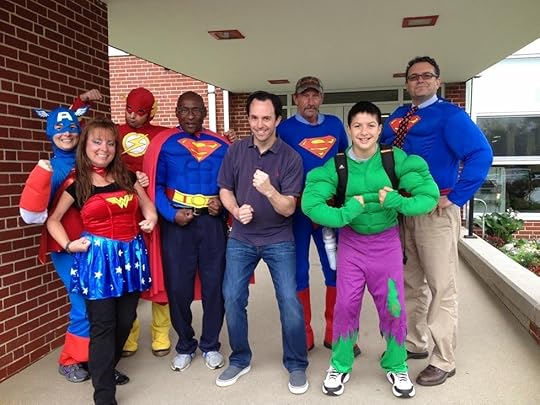
Apparently they've upped their Superman quota.
(Calling Jarrett J. Krosoczka: Jarrettown Elementary is in Dresher, PA. And while you’re at it, I’d also hit up Jarrett Middle School…in Honolulu.)
My host Jennifer Ruiter could not have capped my speaking season with more infectious enthusiasm. The school is lucky to have her on board, and I can say the same about the other educators I met there.
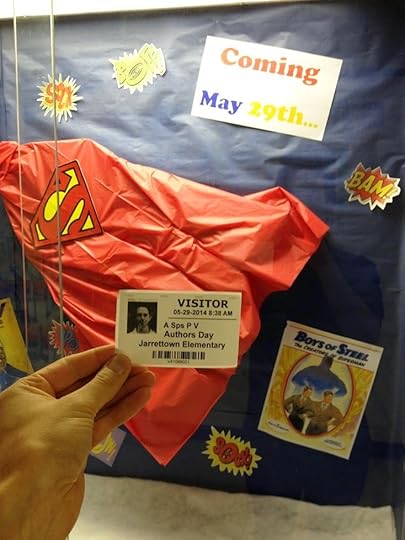
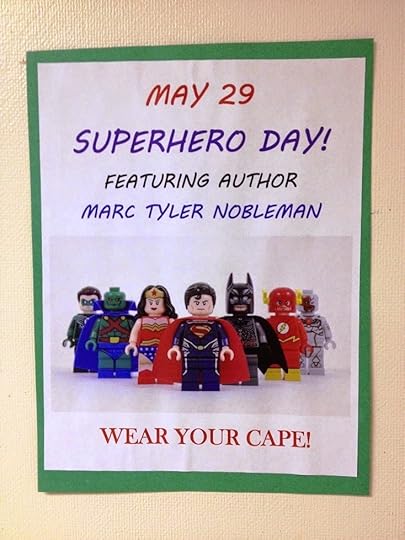
After Jennifer took a few photos of the group flexing, she said “Now let’s do one with the flash.” To which the Flash responded “I’ve been here all along.”
Published on May 31, 2014 04:00
May 30, 2014
Full video of "Batman at 75" panel at the Paley Center
Kevin Conroy, Chip Kidd, Kevin Smith, Michael Uslan, and I were told that only a three-minute clip of our 5/5/14 panel would be posted.
But we were then surprised with the whole thing.

Thank you to Travis Langley for recapping Bill Finger highlights of the panel, some of which I am restating here:
37:00 Whitney asks the question that leads me to talk about Bill.41:30 Michael honors Bill in this year of Bill’s 100th birthday by introducing granddaughter Athena Finger, who was in attendance.54:00 Marc discusses what Bill belonging Charles Sinclair gave to him.1:00:00 Audience questions begin. The first person asks Marc about the most surprising thing he’d discovered when researching Bill.
But we were then surprised with the whole thing.

Thank you to Travis Langley for recapping Bill Finger highlights of the panel, some of which I am restating here:
37:00 Whitney asks the question that leads me to talk about Bill.41:30 Michael honors Bill in this year of Bill’s 100th birthday by introducing granddaughter Athena Finger, who was in attendance.54:00 Marc discusses what Bill belonging Charles Sinclair gave to him.1:00:00 Audience questions begin. The first person asks Marc about the most surprising thing he’d discovered when researching Bill.
Published on May 30, 2014 04:00
May 29, 2014
“The Chupacabra Ate the Candelabra”: my first funny picture book
I’m several miles above thrilled to announce my first funny picture book (though not my first book to mention the chupacabra).
The 5/23/14 announcement (the chupannouncement, if you will…oh, you won’t?) from Publishers Marketplace:
The 5/23/14 announcement (the chupannouncement, if you will…oh, you won’t?) from Publishers Marketplace:
Boys of Steel author Marc Tyler Nobleman's The Chupacabra Ate the Candelabra, in which a twitchy herd of goats sets out to scare off the legendary chupacabra, a monster that allegedly eats goats—and only goats—only to find that neither their own bravery nor the chupacabra's actual cravings are what they were expecting, to Nancy Paulsen at Nancy Paulsen Books, by Emily van Beek at Folio Literary Management (World).
Published on May 29, 2014 04:00
May 28, 2014
“Survivor”-themed 10th birthday party
Twelve kids.
Nine challenges.
Four hours.
One Survivor!
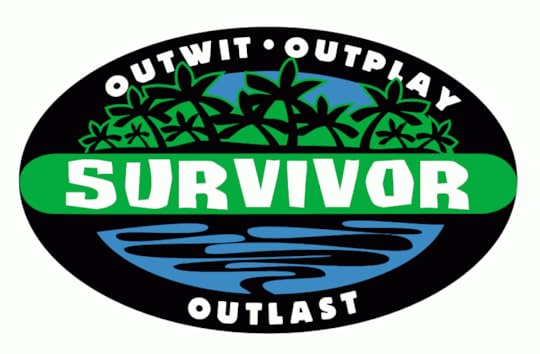
Yes, the girls had to vote each other out. And were great sports about it, as the photos and three short videos below illustrate.
The background:
My love of the TV show Survivor led to my daughter’s love of Survivor which led to a Survivor-themed 10th birthday party. Knowing this would be rather involved, I started planning it soon after her 9th birthday.
I wondered if it would be upsetting (to the girls, the parents, or both) if we retained the elimination aspect. But I believe in honest competition and facing fear and teaching young people how to lose gracefully. So we kept in voting out (though we did not allow forming alliances, not that there would have been time anyway).
I told the girls that they are friends first, Survivors second. I said that being voted out is a compliment—it means others think you are good enough to beat them. And believe me, every girl wanted to win.
I asked them to think of other games they love to play with friends (chess, Uno, Monopoly)—and asked them to think of how they feel when a friend wins. Then I asked them to imagine if those other games allowed you to get rid of your competition. They understood...and seemed to like the prospect.
It was game on.
How it worked:
The Survivors were asked to come in white T-shirts, shorts with pockets (in case they found the hidden immunity idol), and sneakers.Soon as they arrived at 5 p.m., they ate hot dogs and hamburgers (we spared them rice) while I showed them relevant clips from several episodes of Survivor:
We experienced two setbacks while setting up and two mishaps during the game.
The setbacks:
Two hours before the Survivors arrived, we discovered that a squirrel had gnawed a hole in the hose connecting the grill to the propane tank; my wife shrewdly duct-taped it so the young Survivors would not starve as their adult counterparts often do.An hour and a half before the Survivors arrived, as I tested the two eight-foot planks that the players would have to cross, one snapped under my weight; I rushed to the nearest hardware store for a replacement.
The mishaps:
One player fell when the plank slid out from under her; luckily the grass underfoot was soft and after I repositioned the plank, she got right back on.One player cut her lip while trying to catch an ice cube in her mouth (for a challenge).
At least no one was medically evacuated. And no tears, only cheers—of support, for their teammates when voted out as much as when giving their all.
The photos/videos:
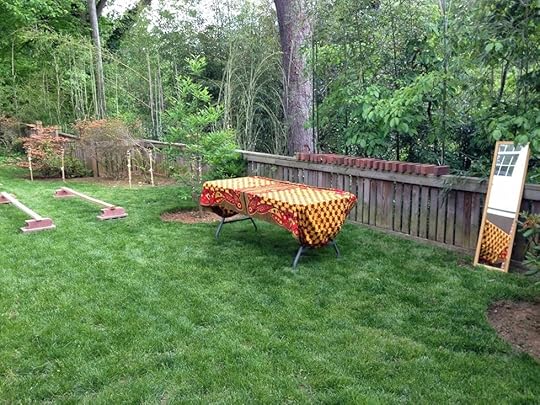 Competition site. Note bricks along fence. They will come into play soon.
Competition site. Note bricks along fence. They will come into play soon.
 Tiki torches and team mats.
Tiki torches and team mats.
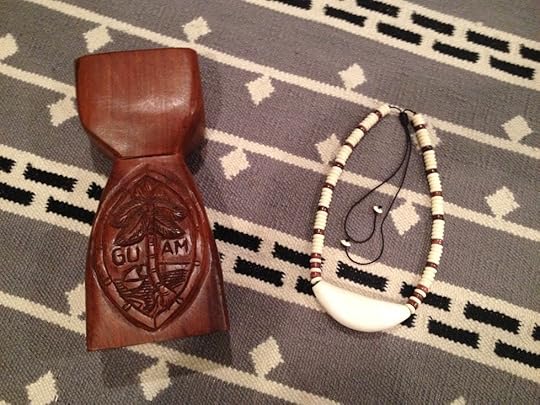 Tribal immunity and individual immunity. Both from Guam.
Tribal immunity and individual immunity. Both from Guam.
 Tribal council. Bonus: a window.
Tribal council. Bonus: a window.
 The voting slips and box.
The voting slips and box.
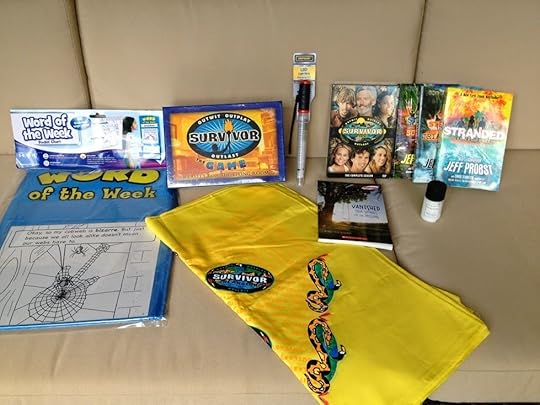 Rewards included Survivor bandanas, a Survivor board game, Survivor-inspired adventure novels for kids thanks to my generous author friend Chris Tebbetts, a book I wrote called Vanished, an LED light stick (three colors!), shampoos/lotions (thanks Holiday Inn or Homewood Suites), and for the Sole Survivor, the DVD of the complete season of Survivor Palau.
Rewards included Survivor bandanas, a Survivor board game, Survivor-inspired adventure novels for kids thanks to my generous author friend Chris Tebbetts, a book I wrote called Vanished, an LED light stick (three colors!), shampoos/lotions (thanks Holiday Inn or Homewood Suites), and for the Sole Survivor, the DVD of the complete season of Survivor Palau.
 Gift/reward bags and Survivor music.
Gift/reward bags and Survivor music.
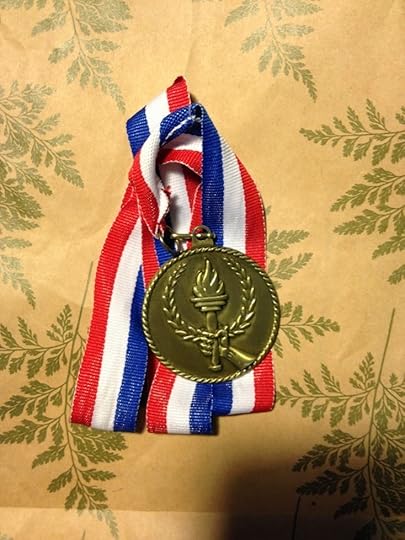 The hidden immunity idol (AKA Field Day medal).
The hidden immunity idol (AKA Field Day medal).
 Can you find it? (One of the girls did even though I forgot to announce it!)
Can you find it? (One of the girls did even though I forgot to announce it!)
 Survivors watching Survivor.
Survivors watching Survivor.
 The orange (fire) team.
The orange (fire) team.
 The blue (water) team.
The blue (water) team.
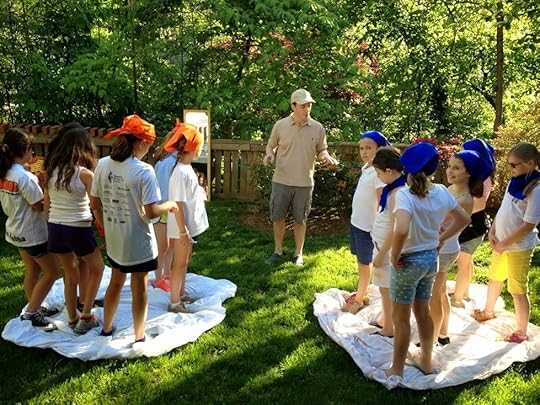 Me as Jeff Probst explaining Challenge #1: strategy. Each team stands on an island (i.e. bedsheet); first team to flip its island without any player stepping off wins.
Me as Jeff Probst explaining Challenge #1: strategy. Each team stands on an island (i.e. bedsheet); first team to flip its island without any player stepping off wins.
 The second tribal council.
The second tribal council.
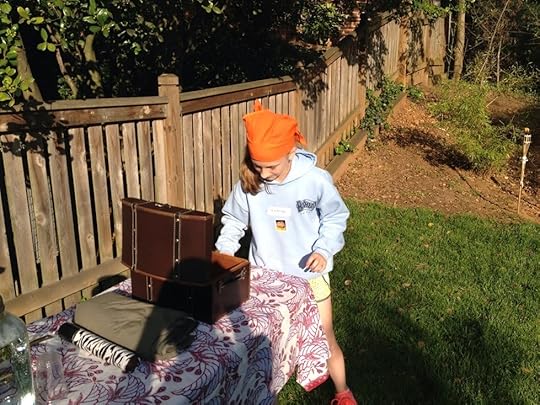 Voting.
Voting.
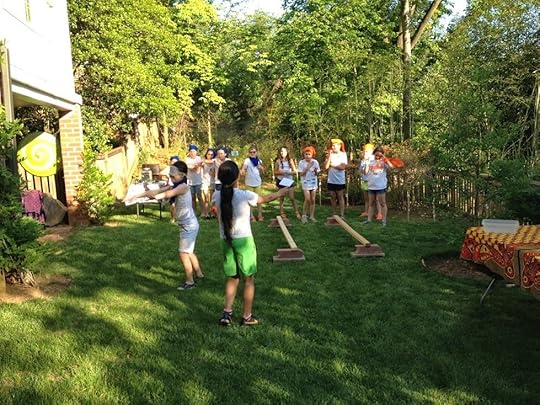 Challenge #2: giving/following direction. Callers guide
Challenge #2: giving/following direction. Callers guide
blindfolded teammates in picking up five team-colored flags
scattered across yard; first team to return all five of their flags
to its mat wins.
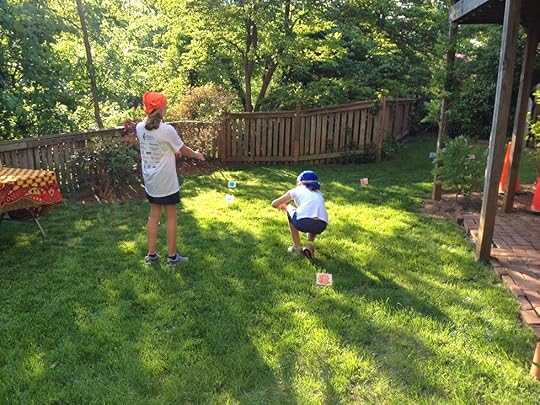

 Challenge #3: balance/aim. Survivors must walk a plank holding a cup of water and toss as much of that water as they can into a container; once all team members have crossed, team whose container holds more water wins.
Challenge #3: balance/aim. Survivors must walk a plank holding a cup of water and toss as much of that water as they can into a container; once all team members have crossed, team whose container holds more water wins.
 Challenge #4: puzzle. First team to complete a 100-piece rainforest puzzle wins.Twist: teams did not know till piece #99 that piece #100 washidden somewhere in the yard.
Challenge #4: puzzle. First team to complete a 100-piece rainforest puzzle wins.Twist: teams did not know till piece #99 that piece #100 washidden somewhere in the yard.
 Blue team finished first (it took 18 minutes); look hard and you might notice the gap for the missing final piece they are off searching for.
Blue team finished first (it took 18 minutes); look hard and you might notice the gap for the missing final piece they are off searching for.
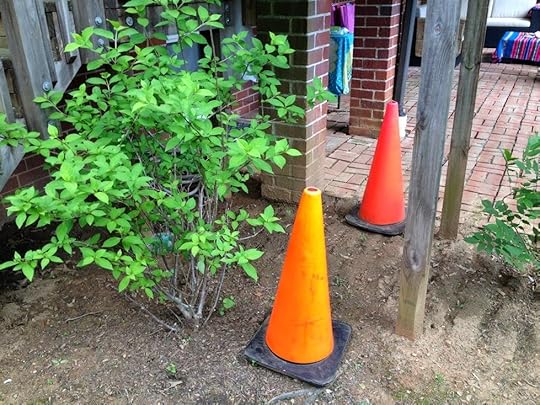 Can you spot it?
Can you spot it?
Testing the hidden piece they found.
 After four group challenges, the tribes merged and took a break from the game to apply face paint.
After four group challenges, the tribes merged and took a break from the game to apply face paint.
 Merged and merry.
Merged and merry.
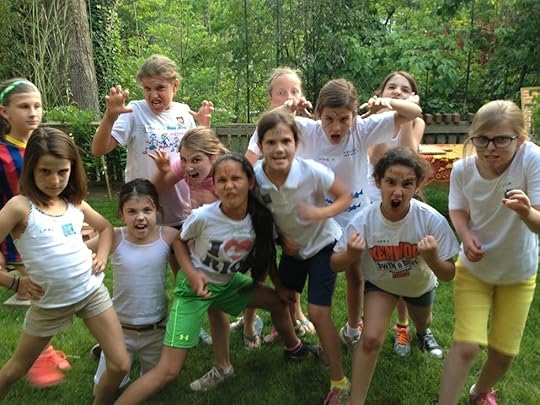 Merged and menacing.
Merged and menacing.
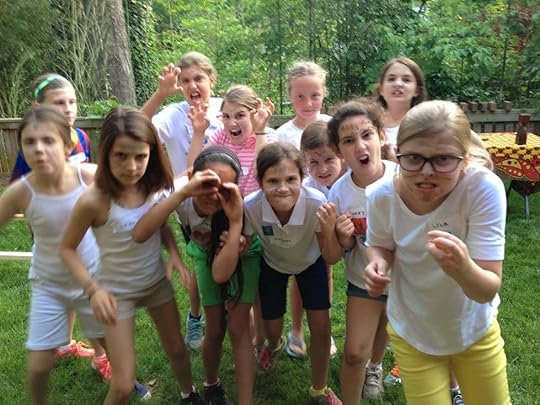 Merged, menacing, and approaching.
Merged, menacing, and approaching.
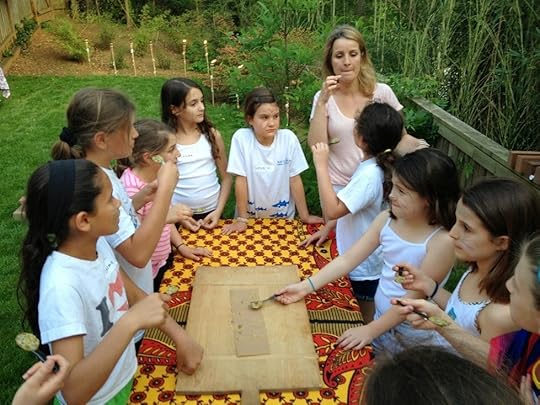 Challenge #5: courage/mind over matter. The dreaded food challenge.Dish #1: a dill mustard/relish combo. Most ate it.Dish #2: vegetarian caviar (seaweed). Some ate it. Some gagged.Dish #3: crickets.
Challenge #5: courage/mind over matter. The dreaded food challenge.Dish #1: a dill mustard/relish combo. Most ate it.Dish #2: vegetarian caviar (seaweed). Some ate it. Some gagged.Dish #3: crickets.
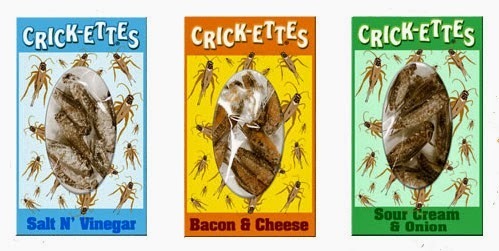 Technically crick-ettes. (But still crickets. And three ate one!)
Technically crick-ettes. (But still crickets. And three ate one!)
Eating caviar.
Revealing the crickets.
 Challenge #6: strength/endurance. Hold out two bricks (five pounds each) as long as you can. I now know five pounds is a bit too heavy for 10-year-olds.
Challenge #6: strength/endurance. Hold out two bricks (five pounds each) as long as you can. I now know five pounds is a bit too heavy for 10-year-olds.

 Challenge #7: dexterity. Toss snowballs (saved in freezer from winter) without dropping or crushing.
Challenge #7: dexterity. Toss snowballs (saved in freezer from winter) without dropping or crushing.
 Challenge #8: memory. Survivors must arrange up to seven island-themed pictures (anchor, canoe, castle, palm tree, shell, turtle, volcano) in the order I just showed them. I started with three images; all four Survivors aced that and the next round. Winner remembered six.
Challenge #8: memory. Survivors must arrange up to seven island-themed pictures (anchor, canoe, castle, palm tree, shell, turtle, volcano) in the order I just showed them. I started with three images; all four Survivors aced that and the next round. Winner remembered six.
 The final three.
The final three.
In the excitement, I did not photograph the winner (above on left).
Nine challenges.
Four hours.
One Survivor!

Yes, the girls had to vote each other out. And were great sports about it, as the photos and three short videos below illustrate.
The background:
My love of the TV show Survivor led to my daughter’s love of Survivor which led to a Survivor-themed 10th birthday party. Knowing this would be rather involved, I started planning it soon after her 9th birthday.
I wondered if it would be upsetting (to the girls, the parents, or both) if we retained the elimination aspect. But I believe in honest competition and facing fear and teaching young people how to lose gracefully. So we kept in voting out (though we did not allow forming alliances, not that there would have been time anyway).
I told the girls that they are friends first, Survivors second. I said that being voted out is a compliment—it means others think you are good enough to beat them. And believe me, every girl wanted to win.
I asked them to think of other games they love to play with friends (chess, Uno, Monopoly)—and asked them to think of how they feel when a friend wins. Then I asked them to imagine if those other games allowed you to get rid of your competition. They understood...and seemed to like the prospect.
It was game on.
How it worked:
The Survivors were asked to come in white T-shirts, shorts with pockets (in case they found the hidden immunity idol), and sneakers.Soon as they arrived at 5 p.m., they ate hot dogs and hamburgers (we spared them rice) while I showed them relevant clips from several episodes of Survivor:
an introduction (how the competitors meet and start the game)a mergea food challengean endurance challengea tribal councilTo form two teams of six, they randomly drew buffs (either blue or orange bandanas). They each got a matching Survivor sticker (blue = water, orange = fire) and a nametag. (As in real Survivor, not all the players knew each other beforehand; it was a mix of friends from school, the neighborhood, ballet, etc.). They had five minutes to come up with a tribe name (my only parameter: the name could not be an English word) and draw a tribe banner using only different shades of their respective tribe colors.With Survivor music playing, they entered the arena with titters and a few jitters.Some challenges were for immunity and reward, and some just immunity. It went challenge, tribal council, challenge, tribal council…no down time. Players voted out could participate in most subsequent challenges (it was a party), but they could not win rewards or vote at tribal council.They merged at eight players, at which time they dropped their buffs and had five minutes to apply tribal face paint.The party was scheduled to start early enough so most of the challenges were in daylight but late enough so that the last couple—and, most importantly, the last tribal council—were in the dark.
We experienced two setbacks while setting up and two mishaps during the game.
The setbacks:
Two hours before the Survivors arrived, we discovered that a squirrel had gnawed a hole in the hose connecting the grill to the propane tank; my wife shrewdly duct-taped it so the young Survivors would not starve as their adult counterparts often do.An hour and a half before the Survivors arrived, as I tested the two eight-foot planks that the players would have to cross, one snapped under my weight; I rushed to the nearest hardware store for a replacement.
The mishaps:
One player fell when the plank slid out from under her; luckily the grass underfoot was soft and after I repositioned the plank, she got right back on.One player cut her lip while trying to catch an ice cube in her mouth (for a challenge).
At least no one was medically evacuated. And no tears, only cheers—of support, for their teammates when voted out as much as when giving their all.
The photos/videos:
 Competition site. Note bricks along fence. They will come into play soon.
Competition site. Note bricks along fence. They will come into play soon. Tiki torches and team mats.
Tiki torches and team mats. Tribal immunity and individual immunity. Both from Guam.
Tribal immunity and individual immunity. Both from Guam. Tribal council. Bonus: a window.
Tribal council. Bonus: a window. The voting slips and box.
The voting slips and box. Rewards included Survivor bandanas, a Survivor board game, Survivor-inspired adventure novels for kids thanks to my generous author friend Chris Tebbetts, a book I wrote called Vanished, an LED light stick (three colors!), shampoos/lotions (thanks Holiday Inn or Homewood Suites), and for the Sole Survivor, the DVD of the complete season of Survivor Palau.
Rewards included Survivor bandanas, a Survivor board game, Survivor-inspired adventure novels for kids thanks to my generous author friend Chris Tebbetts, a book I wrote called Vanished, an LED light stick (three colors!), shampoos/lotions (thanks Holiday Inn or Homewood Suites), and for the Sole Survivor, the DVD of the complete season of Survivor Palau. Gift/reward bags and Survivor music.
Gift/reward bags and Survivor music. The hidden immunity idol (AKA Field Day medal).
The hidden immunity idol (AKA Field Day medal). Can you find it? (One of the girls did even though I forgot to announce it!)
Can you find it? (One of the girls did even though I forgot to announce it!) Survivors watching Survivor.
Survivors watching Survivor. The orange (fire) team.
The orange (fire) team. The blue (water) team.
The blue (water) team. Me as Jeff Probst explaining Challenge #1: strategy. Each team stands on an island (i.e. bedsheet); first team to flip its island without any player stepping off wins.
Me as Jeff Probst explaining Challenge #1: strategy. Each team stands on an island (i.e. bedsheet); first team to flip its island without any player stepping off wins.  The second tribal council.
The second tribal council. Voting.
Voting. Challenge #2: giving/following direction. Callers guide
Challenge #2: giving/following direction. Callers guide blindfolded teammates in picking up five team-colored flags
scattered across yard; first team to return all five of their flags
to its mat wins.


 Challenge #3: balance/aim. Survivors must walk a plank holding a cup of water and toss as much of that water as they can into a container; once all team members have crossed, team whose container holds more water wins.
Challenge #3: balance/aim. Survivors must walk a plank holding a cup of water and toss as much of that water as they can into a container; once all team members have crossed, team whose container holds more water wins. Challenge #4: puzzle. First team to complete a 100-piece rainforest puzzle wins.Twist: teams did not know till piece #99 that piece #100 washidden somewhere in the yard.
Challenge #4: puzzle. First team to complete a 100-piece rainforest puzzle wins.Twist: teams did not know till piece #99 that piece #100 washidden somewhere in the yard. Blue team finished first (it took 18 minutes); look hard and you might notice the gap for the missing final piece they are off searching for.
Blue team finished first (it took 18 minutes); look hard and you might notice the gap for the missing final piece they are off searching for. Can you spot it?
Can you spot it?Testing the hidden piece they found.
 After four group challenges, the tribes merged and took a break from the game to apply face paint.
After four group challenges, the tribes merged and took a break from the game to apply face paint. Merged and merry.
Merged and merry. Merged and menacing.
Merged and menacing. Merged, menacing, and approaching.
Merged, menacing, and approaching. Challenge #5: courage/mind over matter. The dreaded food challenge.Dish #1: a dill mustard/relish combo. Most ate it.Dish #2: vegetarian caviar (seaweed). Some ate it. Some gagged.Dish #3: crickets.
Challenge #5: courage/mind over matter. The dreaded food challenge.Dish #1: a dill mustard/relish combo. Most ate it.Dish #2: vegetarian caviar (seaweed). Some ate it. Some gagged.Dish #3: crickets. Technically crick-ettes. (But still crickets. And three ate one!)
Technically crick-ettes. (But still crickets. And three ate one!)Eating caviar.
Revealing the crickets.
 Challenge #6: strength/endurance. Hold out two bricks (five pounds each) as long as you can. I now know five pounds is a bit too heavy for 10-year-olds.
Challenge #6: strength/endurance. Hold out two bricks (five pounds each) as long as you can. I now know five pounds is a bit too heavy for 10-year-olds. 
 Challenge #7: dexterity. Toss snowballs (saved in freezer from winter) without dropping or crushing.
Challenge #7: dexterity. Toss snowballs (saved in freezer from winter) without dropping or crushing. Challenge #8: memory. Survivors must arrange up to seven island-themed pictures (anchor, canoe, castle, palm tree, shell, turtle, volcano) in the order I just showed them. I started with three images; all four Survivors aced that and the next round. Winner remembered six.
Challenge #8: memory. Survivors must arrange up to seven island-themed pictures (anchor, canoe, castle, palm tree, shell, turtle, volcano) in the order I just showed them. I started with three images; all four Survivors aced that and the next round. Winner remembered six. The final three.
The final three.In the excitement, I did not photograph the winner (above on left).
Published on May 28, 2014 04:00
May 27, 2014
“The Odd-Shaped Object,” an unpublished 1968 picture book
As a child, I vividly remember poring over an unpublished picture book manuscript in our family’s possession; I was especially captivated by the multicolored rug that plays into the story (but that was not The Odd-Shaped Object of the title).
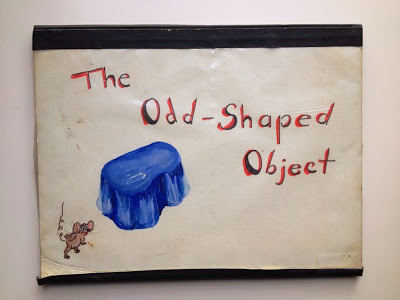
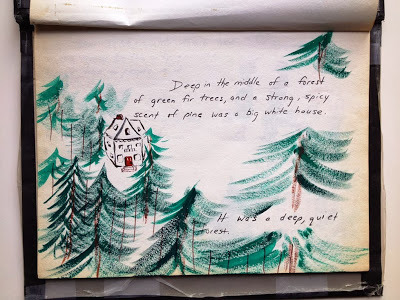
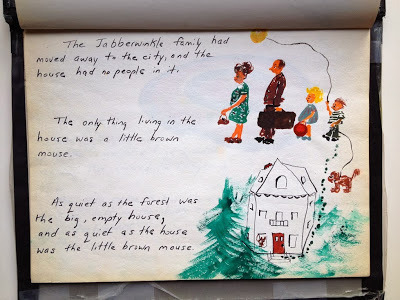
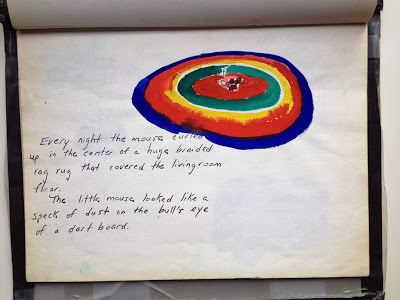
The author/illustrator (whose day job was elementary school teacher) saved not only the original art but also notes for the cover letter…and a rejection letter she received in 1968.
Four years later, she would have a son who would grow up to go through similar experiences.
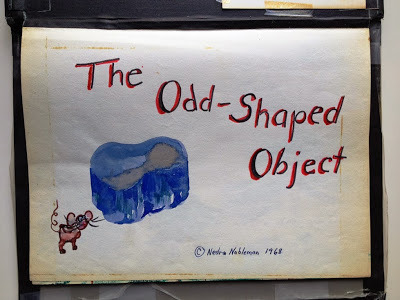
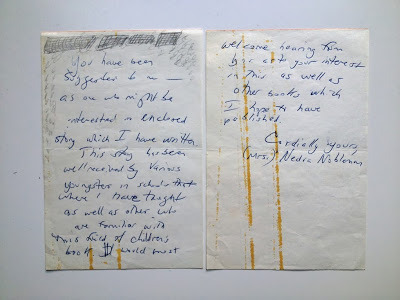
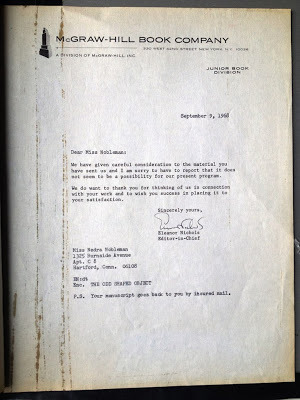
Eleanor Nichols, the editor who turned down my mom before she was my mom, worked at McGraw-Hill for 30 years, retiring in 1990 and passing away in 2000.
I love you, mom, for being my ongoing creative influence and so, so much more.
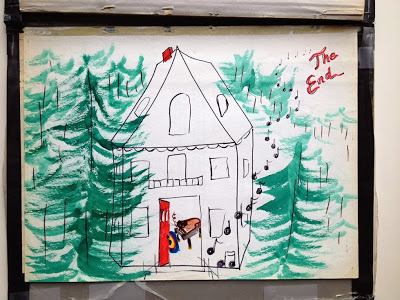




The author/illustrator (whose day job was elementary school teacher) saved not only the original art but also notes for the cover letter…and a rejection letter she received in 1968.
Four years later, she would have a son who would grow up to go through similar experiences.



Eleanor Nichols, the editor who turned down my mom before she was my mom, worked at McGraw-Hill for 30 years, retiring in 1990 and passing away in 2000.
I love you, mom, for being my ongoing creative influence and so, so much more.

Published on May 27, 2014 04:00



